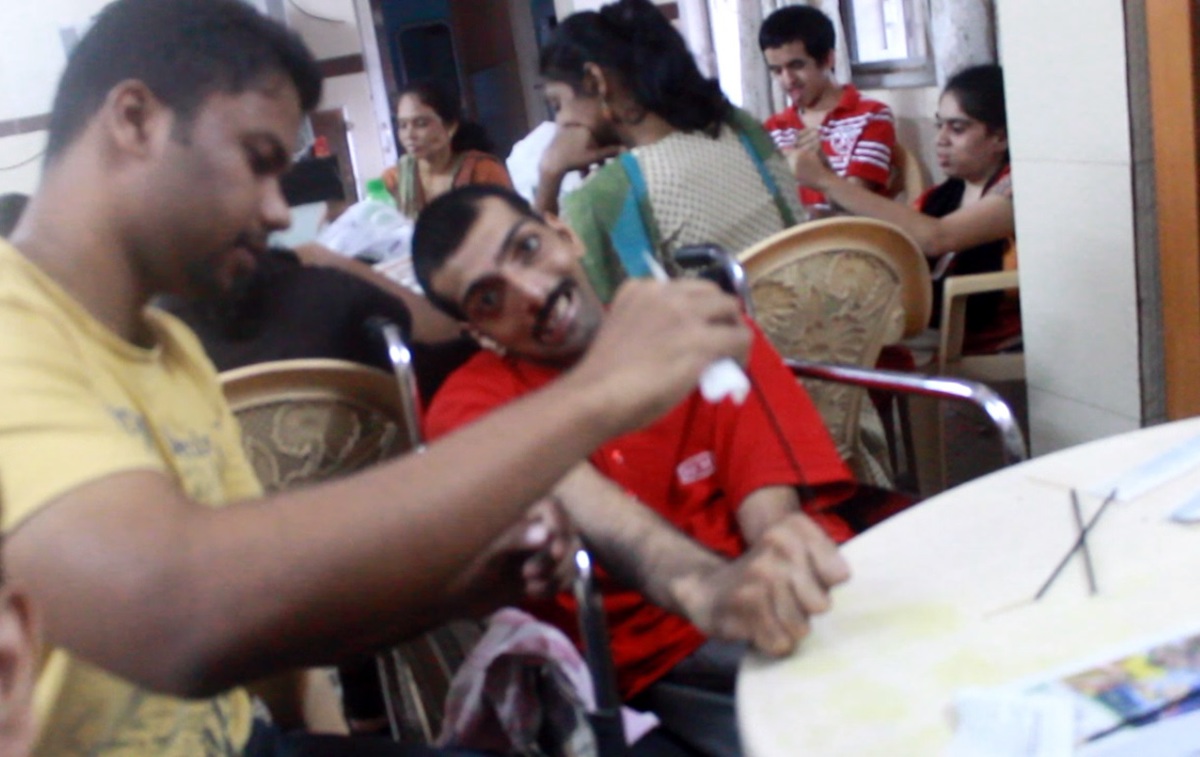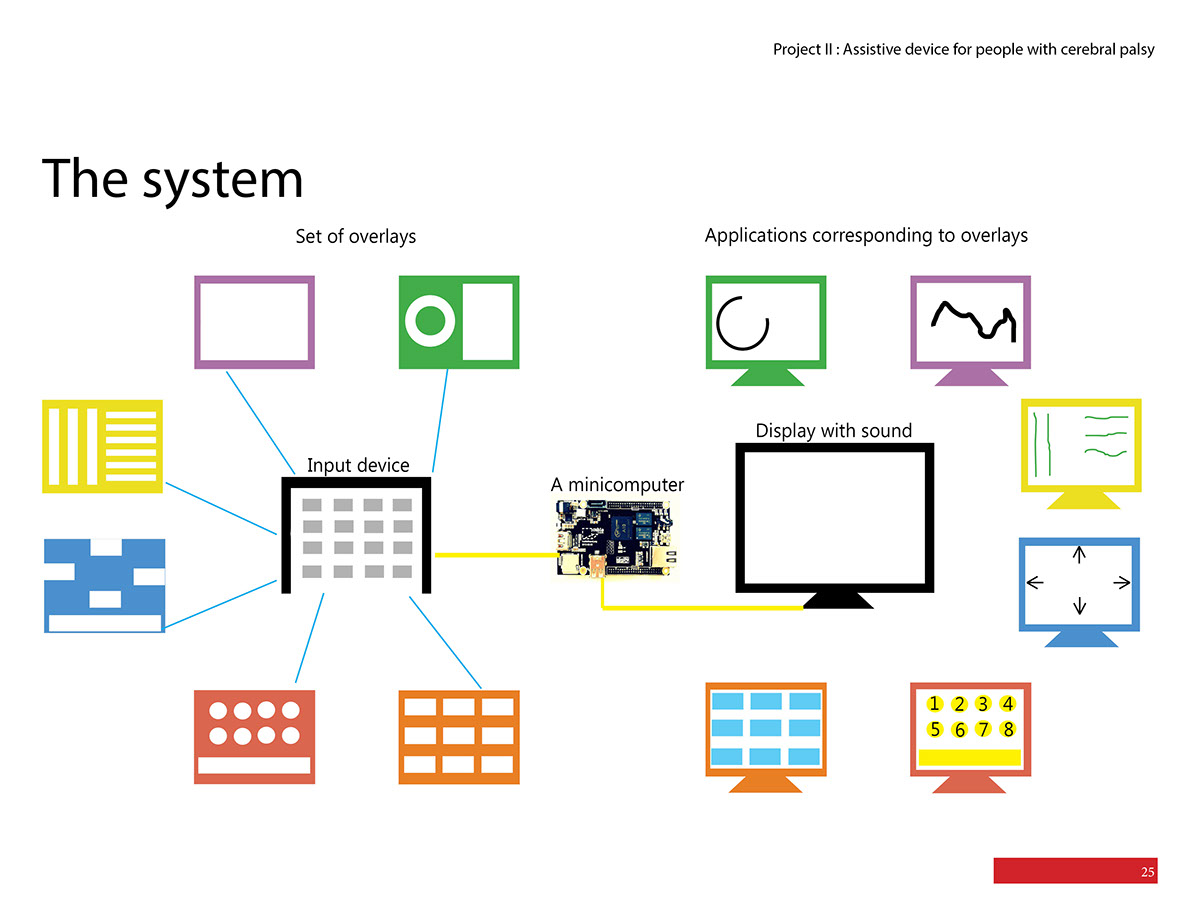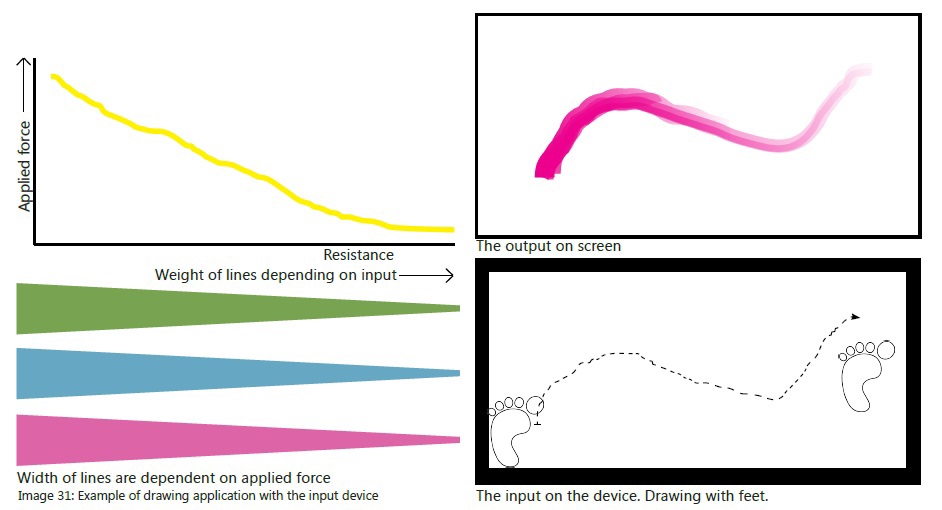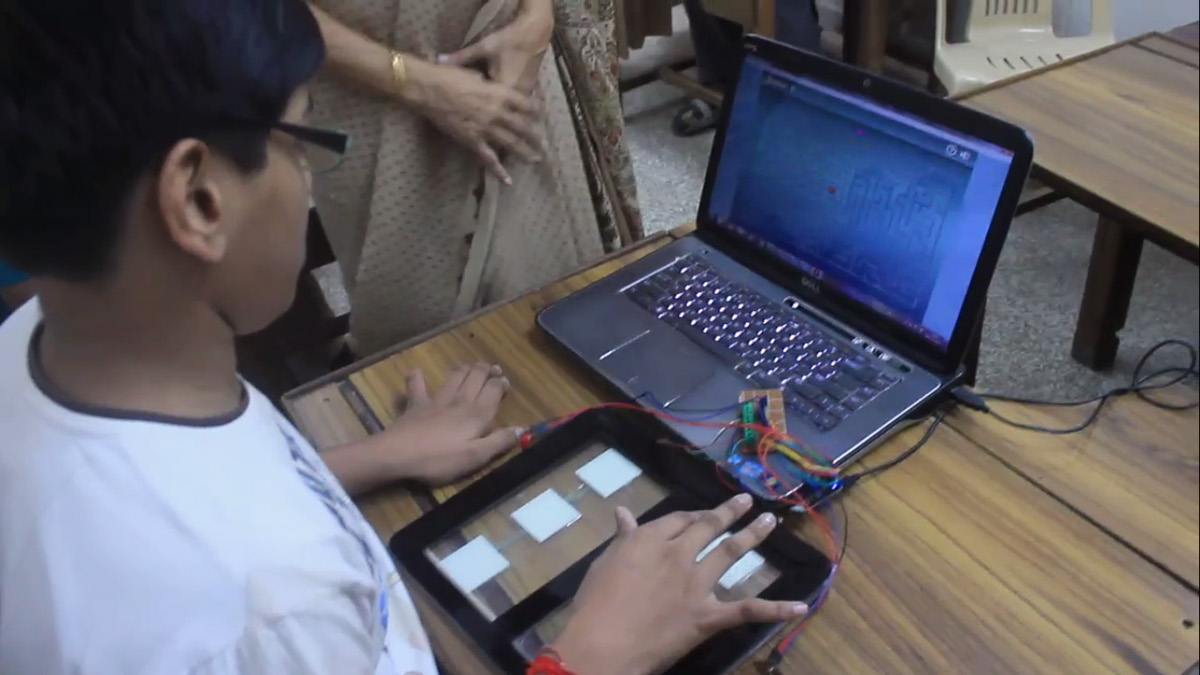
The objective of the device is to help people with CP in communicating their basic needs to their care takers around them. Apart from communication, the device would also be used for training their motor skills, recreational activities and teaching various topics. The popular input devices like mouse or keyboard require fine motor skills to give input to computers which is not possible for people with spastic CP. The solution proposed here is a tangible device that is pressure sensitive. It takes the input signal of gross motor movement, like tapping of foot or hands and converts it into meaningful information. It can recognise the position and the pressure of fingers touching it. This device can be attached to any computer and be used for various applications. The solution describes how the users would interact with the device for applications of motor skill development, communication and recreational activities.




The systems of human body can be classified as a closed loop feedback system. A system which would self correct itself while constantly comparing a desired value. A system is defined by inputs, processes and outputs. Any task which is executed
by humans can be modelled as closed loop model. As shown in the diagram, a simple task of walking by human being
can be modelled by a closed loop feedback model. Let’s say,a person wants to move to a desired position then the
error would be the difference between desired and current location. The Environment (static) would be roads, pillars, and
dividers. Actuation is the motion of legs for walking and output is the change in position of that person. But there are
some cases when this does not work as expected. Like a case of CP, in which the inputs i.e. the sensory organs may not
function as expected or some maybe mentally challenged or with physical disability.
by humans can be modelled as closed loop model. As shown in the diagram, a simple task of walking by human being
can be modelled by a closed loop feedback model. Let’s say,a person wants to move to a desired position then the
error would be the difference between desired and current location. The Environment (static) would be roads, pillars, and
dividers. Actuation is the motion of legs for walking and output is the change in position of that person. But there are
some cases when this does not work as expected. Like a case of CP, in which the inputs i.e. the sensory organs may not
function as expected or some maybe mentally challenged or with physical disability.
Cerebral palsy causes permanent damage to the brain and physical disabilities. The motor disorders may affect a child’s ability
to walk or perform manipulative tasks, and may make overall arm and leg movements slow or unsteady. In addition, the brain
injury may cause other medical disorders, such as impaired intellectual development, seizures, and spinal deformities. It may
also delay the growth of a child, effect vision, speech, hearing or behaviour.
to walk or perform manipulative tasks, and may make overall arm and leg movements slow or unsteady. In addition, the brain
injury may cause other medical disorders, such as impaired intellectual development, seizures, and spinal deformities. It may
also delay the growth of a child, effect vision, speech, hearing or behaviour.

Insights from User study
1. People with CP have spasticity, which hampers them in making fine motor movement. It is dificult for them to make precise
controlled movement.
2. Every person with CP has unique set of disability. Therefore, individual cases have be looked at separately. In order to come up with an assistive device, a set of tools has to be developed which can be used by them as per their need.
3. A person with disability may have combinations of disability due to various reasons. People may have physical disability coupled with mental retardation.
4. Sometimes, a little modiication in normal devices can lead to great benefit for people with disability, e.g. a key board with
overlay for key press.
5. For people with disability, working and being self dependent is dream. If by any means they are able to do it,
they would be satisied.
6. CP treatment is an area that has begun to beneit greatly from emerging technologies. There are various AAC and therapeutic applications available on smart phones and tablet but their use is restricted to unavailability of suitable input device.
7. Developing therapy or tools for occupational therapy shall be beneicial for the students. As it helps them to work
eficiently.
1. People with CP have spasticity, which hampers them in making fine motor movement. It is dificult for them to make precise
controlled movement.
2. Every person with CP has unique set of disability. Therefore, individual cases have be looked at separately. In order to come up with an assistive device, a set of tools has to be developed which can be used by them as per their need.
3. A person with disability may have combinations of disability due to various reasons. People may have physical disability coupled with mental retardation.
4. Sometimes, a little modiication in normal devices can lead to great benefit for people with disability, e.g. a key board with
overlay for key press.
5. For people with disability, working and being self dependent is dream. If by any means they are able to do it,
they would be satisied.
6. CP treatment is an area that has begun to beneit greatly from emerging technologies. There are various AAC and therapeutic applications available on smart phones and tablet but their use is restricted to unavailability of suitable input device.
7. Developing therapy or tools for occupational therapy shall be beneicial for the students. As it helps them to work
eficiently.
Design Ideas
1. A device that could help people with spasticity to practice linear motion, circular motion, figure "8" etc. These would help
them in Occupational therapy, thereby making their work more productive.
2. A tangible device which can train them for alignment in 3D space. A tool which trains their spatial ability.
3. For those who have speech impairment, a simple way to respond as ‘yes’ and ‘no’ would be of great help.
4. If Multiple key press can be customised on a speciic key it would help in operating complex functions in MS Excel
1. A device that could help people with spasticity to practice linear motion, circular motion, figure "8" etc. These would help
them in Occupational therapy, thereby making their work more productive.
2. A tangible device which can train them for alignment in 3D space. A tool which trains their spatial ability.
3. For those who have speech impairment, a simple way to respond as ‘yes’ and ‘no’ would be of great help.
4. If Multiple key press can be customised on a speciic key it would help in operating complex functions in MS Excel

A thermocole model of the input device. A foot operated mouse model made by acrylic and joystick.
Earlier prototype of the input device consists of a grid of FSR (force sensitive resistor) sensors as shown in sketch.These sensors are sensitive to force applied on it. It was
chosen to be the medium to input information as the person can give taps through his foot or hand. In the following sections various modes of interaction through
this device is explored. The prototype models were made from smaller FSRs. Each grid was 10cm in width, according to the size of a foot. The structure of 3X3 matrix is followed as it is replicated in the interface as well.
Earlier prototype of the input device consists of a grid of FSR (force sensitive resistor) sensors as shown in sketch.These sensors are sensitive to force applied on it. It was
chosen to be the medium to input information as the person can give taps through his foot or hand. In the following sections various modes of interaction through
this device is explored. The prototype models were made from smaller FSRs. Each grid was 10cm in width, according to the size of a foot. The structure of 3X3 matrix is followed as it is replicated in the interface as well.

The vision for the system. The input medium can utilize multi modal channels like eye movement, cheek muscle movement, blowing air, head movement, EEG etc.
The process can include an application for communication, motor skill development, recreation and others.
The out put can be through multi modal channels like visual, auditory and haptics.
The process can include an application for communication, motor skill development, recreation and others.
The out put can be through multi modal channels like visual, auditory and haptics.

The initial concept for the input device consists of a grid of FSRs which has touchscreen mounted on it and above it are interchangeable overlays as shown in sketch. The bottom layer of sensor is to sense the pressure applied by the user. The touchscreen recognises the position of the touch and the overlays helps the user to guide at right spot. The device would be connected to a computer and can be used for various applications.

The reasons why force is taken as an input signal are:
1. It is analog and ranges between value of 0-1024 unlike a switch which is just binary. Therefore it can still have functions of
a switch but with a lot more control options.
2. It gives an opportunity to calibrate device according to Individual’s physical ability.
3. It would help physiotherapist to have longitudinal study of an individual’s muscle strength. This will help in assessing his health and suggesting therapy over a long period of time.
4. Force as an input gives advantage of having applications which can help in developing motor skills, e.g. drawing.
1. It is analog and ranges between value of 0-1024 unlike a switch which is just binary. Therefore it can still have functions of
a switch but with a lot more control options.
2. It gives an opportunity to calibrate device according to Individual’s physical ability.
3. It would help physiotherapist to have longitudinal study of an individual’s muscle strength. This will help in assessing his health and suggesting therapy over a long period of time.
4. Force as an input gives advantage of having applications which can help in developing motor skills, e.g. drawing.






One of the problems that special schools face is what should the children do at their leisure time. Presently all their recreational activity requires the teacher’s
presence. That’s where this system can come in, apart from being assistive device it can also train them through medium of games. A simple application could
be of drawing. Here, the weight of the lines are dependent on the force applied. Similarly various other shapes can be made depending on the input, like the radius of the circle or sides of polygon is dependent on force.
presence. That’s where this system can come in, apart from being assistive device it can also train them through medium of games. A simple application could
be of drawing. Here, the weight of the lines are dependent on the force applied. Similarly various other shapes can be made depending on the input, like the radius of the circle or sides of polygon is dependent on force.

In the user interface, the blocks refer to pictures of objects. Below is the input device with overlay of four divisions, left, right, up and down. The bottom part is to select. The Process UI is a picture grid based system, which can have any number of categories, sub categories and objects within them. It also supports sentence building option. It is scalable and customizable. The text and pictures can be added and replaced any number of times. The output can be taken on any screen and it also supports Text to speech. The user has to select his desired object from the grid. The user has two main tasks, navigation and selection. Presently in the input device there are two parts device, four for direction and one for selection. At initial state, the cursor points to the irst element. When right area is tapped the cursor moves one by one to next element. The user taps move until the cursor points the desired element and then he taps select area. Once the element is selected it is shown on the screen.



The project being displayed at Rashtrapati Bhavan (President's palace) New delhi.
With Prof. Anil Gupta in picture
With Prof. Anil Gupta in picture


